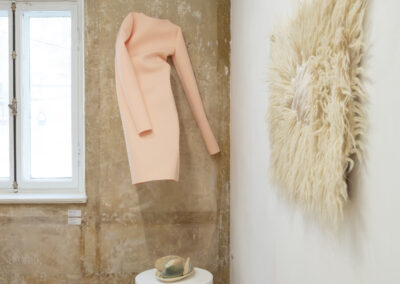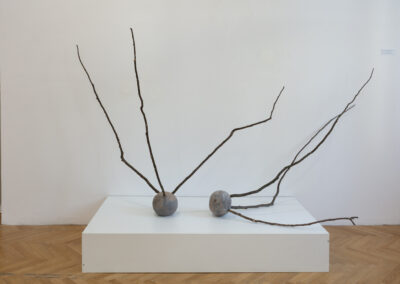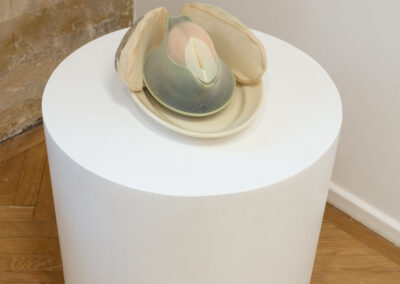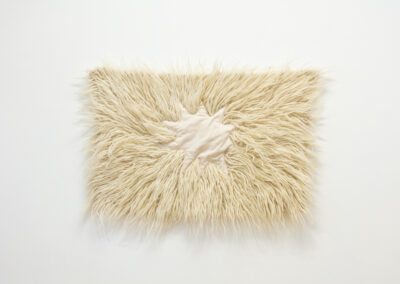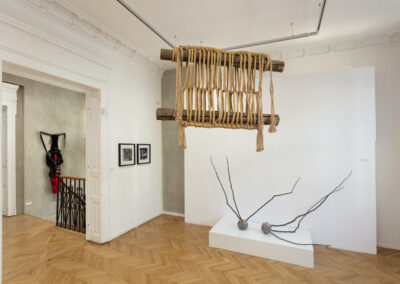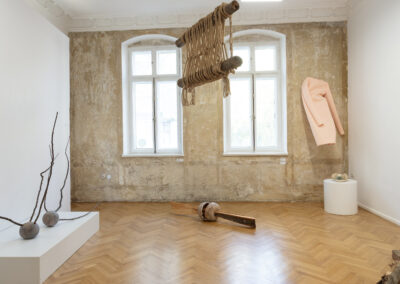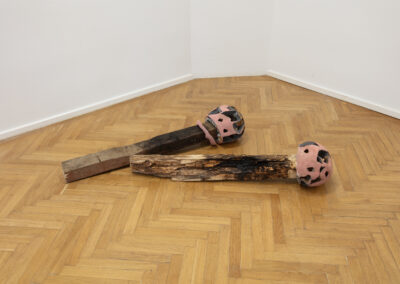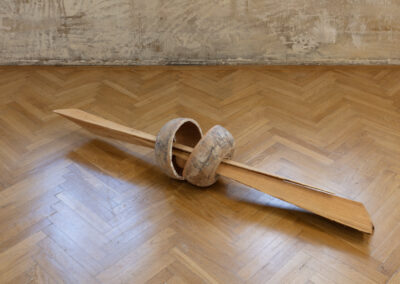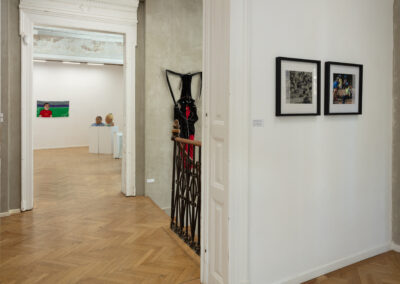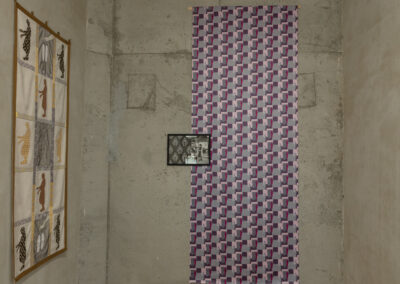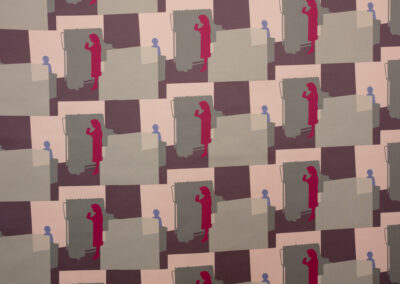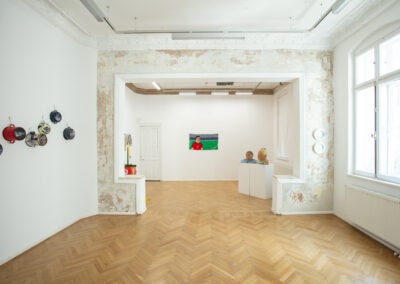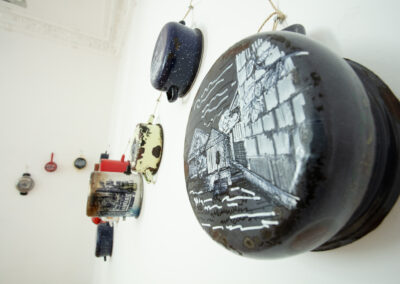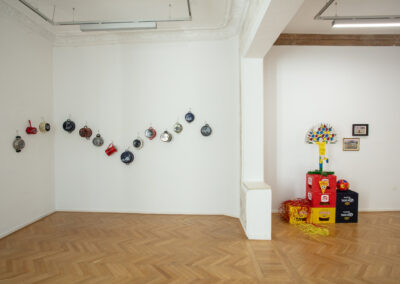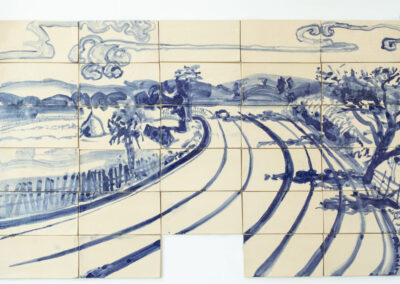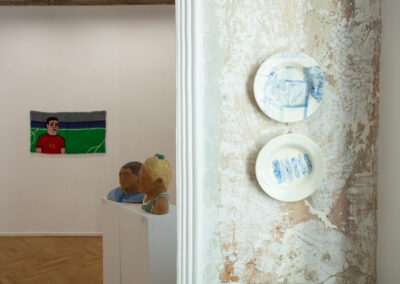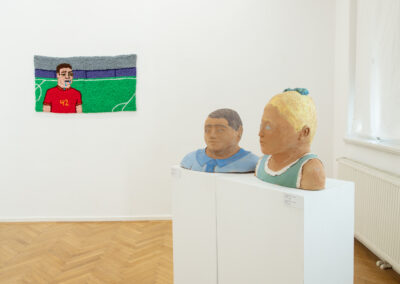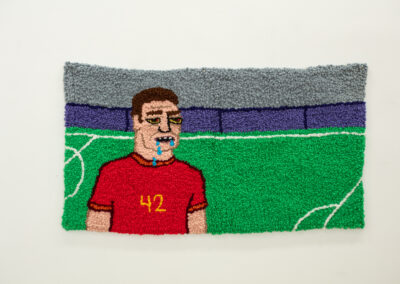The Line of the Valley – Part II
Artists: Yasmina Assbane, Aurora Kiraly, Yana Bachynska, Liesbeth Bik and Jos Van Der Pol, Megan Dominescu, Anetta Mona Chișa, Kamruzzaman Shadhin, Tanja Boukal, Željko Beljan, Bogdan Rata, Dan Visovan, Delia Popa, Mihaela Moldovan, Loredana Ilie, Ilie Mihali, Donald Simionoiu
Curator: Marie Maertens
Artistic Director: Anca Poterasu
Exhibition period: 23 October – 5 December 2024
26 Popa Soare Street, Bucharest
During the summer of 2024, about twenty artists from different practices and nationalities gathered in Săcel, in the Maramureș region. Gallery owner Anca Poterasu had long expressed her desire to establish a residency in her hometown, where the craft of ceramics and weaving is still preserved. Each artist gradually became familiar with this land, where vernacular traditions blend with contemporaneity, ecological respect, and ethics. The adventure could
begin…
After days of observing and discovering the area, workshops were quickly organized, allowing participants to learn ceramics or weaving techniques. Focused on environmental respect and sustainability, the residency project required the artists to work with local materials. A kiln, built on-site, allowed for the firing of ceramics made from regional stoneware, while the wool for the weavings came from village sheep, along with the pigments used to color them. Alongside this respect for the land was the discovery of each artist’s customs, a sort of geographical initiation and personal exploration. The project was then set to travel to Vienna, Zagreb, and simultaneously to Bucharest, continuing the tradition of revisiting ancient customs with reflections on territorial and gender assignments. The reuse of certain materials often proves to be a political and committed act, in response to what was relegated to “women’s hands,” particularly in the mythical Bauhaus, where women were required to study in the weaving workshop. Starting in the 1960s, reclaiming threads and embroidering them became a visible act of emancipation. Today, this practice has become more common, dissolving the boundaries between contemporary art and Arts & Crafts.
In Săcel, this return to materials themselves became evident, as seen with an imposing wood sculpture by the duo Bogdan Rata & Dan Visovan—two majestic columns laid on the ground with geometric surfaces reminiscent of Constantin Brancusi or Romanian vernacular architecture. Wood merged with the earth, as with Ilie Mihali, in a reinterpretation of Arte Povera or Land Art, with sober and almost brutalist constructions. In many cases, the domesticated appearance of the materials gave way to a more untamed, almost wild, nature. The loom was reinterpreted through the lens of Rosalind Krauss’s grid, symbolizing the
ancestral condition of women, which Mihaela Moldovan transformed into a liberating flight. Aurora Kirali revisited the gestures of workers tirelessly weaving on looms, producing patterns with timeless vocabularies. Recently, these endless repetitions have been integrated into performances by dancers and visual artists, highlighting the harms of the working world.
Various interpretations emerge from this idea. Tanja Boukal presents a critical reflection on the historical practice of popular photography used during the Austro-Hungarian Empire to catalog ethnic groups. She juxtaposes a 1900 photograph with a contemporary one of some artists in residence, posing laboriously… a pose materialized using traditional or industrial embroidery techniques. Yet the density of wool remains soft in Loredana Ilie’s work, almost inviting us to touch her piece, inspired by rugs that greet the feet upon getting out of bed. She removes the piece’s original function by hanging it on the wall, where it replaces Albertian projections of the painting as a window to the world, allowing for multiple viewer interpretations. Discussions about these materials and fabrics inevitably bring up issues of feminism and gender or transformation, especially in Yana Bachynska’s work. How do clothing and adornment define us? Do they sometimes flirt with the grotesque? Or do we indulge in a certain eroticism, as with Yasmina Assbane, who enjoys discovering found objects in the cities she visits, assembling them in almost surreal ways. What is collected, discarded, or sold reveals much about a civilization, its expectations, or its desires. What has been sewn by seamstresses in Bucharest also testifies to the migrations of populations.
Meanwhile, bodies, cells, and chemistry are at the heart of the questions raised by Anetta Mona Chiesa. She speaks of connections between atoms as metaphors for our family or romantic interconnections, as well as our fragility and vulnerability. The sense of touch is added through the softness of her ceramics, revealing hours of polishing, evoking our finitude or infinite renewal.
Working with ancestral techniques in a village surrounded by nature naturally raised questions about territory, even domesticity. Delia Popa reflected on the use of the blue so iconic in ceramics, employed since the Persian era and manifesting various topographical transformations, exchanges between peoples, or the scars of colonization. These subtle signs of power are tied to the observation of the evolution of natural and urban environments. For Kamruzzaman Shadin, discovering the area involved observing the different houses in the village and the stories they protect… stories communicated by the suspension of iron pots with evocative colors, particularly when a daughter was of marrying age. After collecting these clues, he drew identical gardens or buildings, presented in the exhibitions as water-like
shapes, echoing the name Maramureș, which comes from the two rivers Mara and Mureș.
However, exploring different cultures can also be approached through the joy of play! Zeljko Beljian, passionate about football, a popular sport that abolishes borders, handcrafted a goal net, knot by knot. Here, play is associated with conviviality and its potential to bridge the unknown without a common language. Or, it can connect us to places we navigate during our wanderings or through our parents, as seen in Megan Dominescu’s work, which uses textiles, wool, and tapestry in pop tones and sometimes provocative settings. She humorously revisits these notions of heritage and vernacular practices.
Donald Simionoiu, after training as a ceramist and pursuing a career as a painter, returned to his original material in Săcel to convey the customs of his time. With a subtle connection to art history, he focused on the portrait—a figure once used to express the authority of kings or prelates—which he transforms into a faux-naïve couple painted in pale blues and yellows. From the peaks of Maramureș to the depths of our inner selves, these contemporary reflections rooted in ancient traditions continue to resonate within us.
Artists for Artists Residency Network (AFAR) is an EU co-funded project, also supported by the Administration of the National Cultural Fund. The residency program aims to improve the mobility of contemporary visual artists and curators in Romania, Germany, Croatia, and Austria. The project is led by the Romanian Association for Contemporary Art (ARAC), in partnership with Goethe Institute Network, the Croatian Association of Fine Artists, and Künstlerhaus Vienna.
The AFAR Network project is co-funded by the European Union. “The views and opinions expressed, however, are solely those of the author(s) and do not necessarily reflect the views of the European Union. Neither the European Union nor the granting authority can be held responsible for them.”
More information on the website: www.afarnetwork.com
The project is also supported by the financial contribution of the Maramureș County Council.
Partners: Goethe Institute Network, Croatian Association of Fine Artists, Künstlerhaus Vienna, Austrian Cultural Forum, French Institute Bucharest.
ARAC is a non-profit organization founded in June 2012, in order to produce and promote contemporary art in Romania and abroad. The initiative of the 58 Plantelor Residency belongs to Anca Poterasu, gallerist and ARAC President. The first edition of the Residency took place in 2015 and it was financed through a grant offered by Norway, Iceland, Liechtenstein and the Romanian Government.

